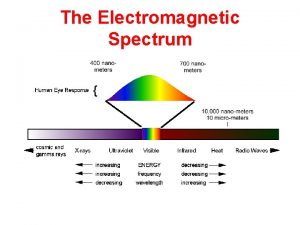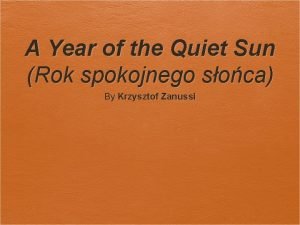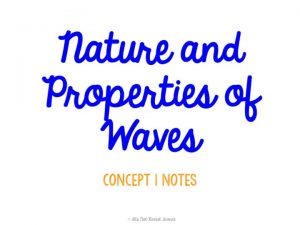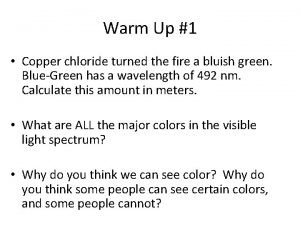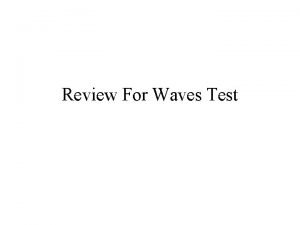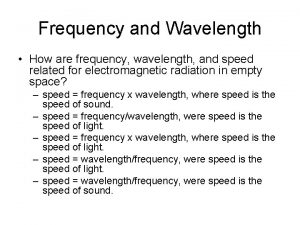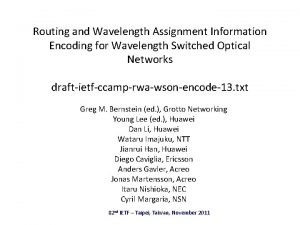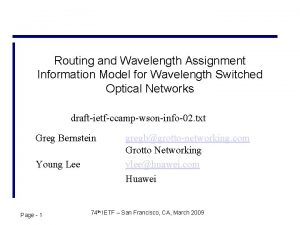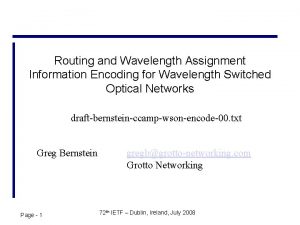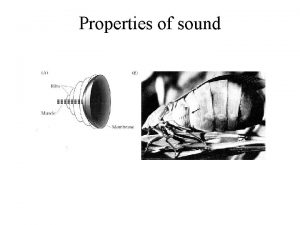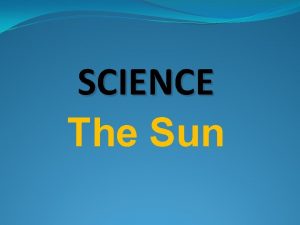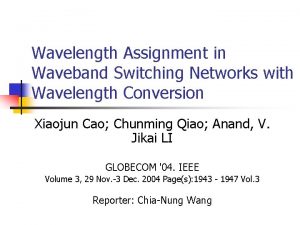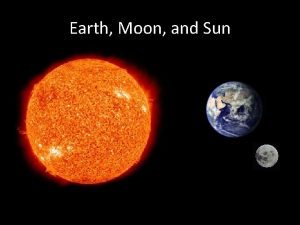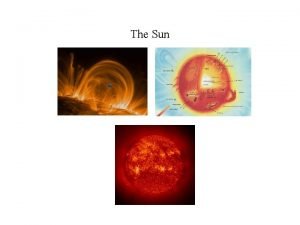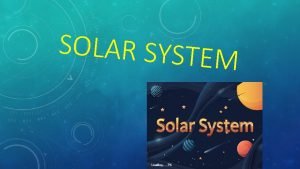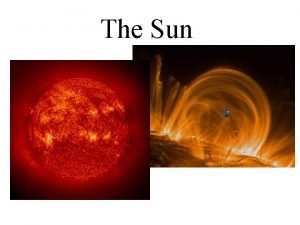Science drivers for wavelength selection Quiet Sun and


























- Slides: 26

Science drivers for wavelength selection: Quiet Sun and Active regions Contribution to the discussions at the EUS meeting / Feb 2006 Hardi Peter Kiepenheuer-Institut Freiburg, Germany

Unique scientific goals of Solar Orbiter Ø Determine the properties, dynamics and interactions of plasma, fields and particles in the near-Sun heliosphere Ø Investigate the links between the solar surface, corona and inner heliosphere Ø Explore, at all latitudes, the energetics, dynamics and fine-scale structure of the Sun's magnetized atmosphere Ø Probe the solar dynamo by observing the Sun's high-latitude field, flows and seismic waves cited from the 1 st announcement for the 2 nd Orbiter Workshop, Oct 2006 cover the whole atmosphere from the photosphere, chromosphere, TR into the corona ° we will get data not much before 2020……….

Outline Ø state of the art models of the solar atmosphere: connecting the convection zone to the corona – – magneto-convection in the photosphere chromospheric models coronal models the future: the whole atmosphere in one model Ø selection of special problems: – – – – where does coronal heating occur? temporal variability coronal heating and small-scale transients wave propagation from the chromosphere into corona Doppler shifts source of the solar wind response to energetic events Ø consequences – – diagnostics through the atmosphere interaction of orbiter instruments diagnostic needs a well suited band

Energy source: photospheric magneto-convection 3 D MHD model of magneto-convection: Diagnostics: – vis. continuum (white light) – magnetic field (vis. & IR Zeeman) G-Band observations Rouppe van der Voort et al. (2006) A&A 435, 327 Vögler, Shelyag, Schüssler et al. (2005) A&A 429, 335

Photosphere ° Chromosphere photosphere: vis. continua & line profiles chromosphere: VUV continua Wedemeyer-Böhm et al. (2004, 2006) 3 D MHD: vis. continuum: 5000 Å VUV continuum: 1600 Å "old" 2 D flux tube Steiner et al. (1997) Ap. J 495, 468 (M)HD models including convection photosphere and chromosphere

Chromosphere °corona Ø fine structured loops – highly dynamic Diagnostics: Ø small loops connecting to “quiet regions” VUV spectral profiles formed at log. T ~ 4. 5… 6. 5 top view side views Peter, Gudiksen & Nordlund (2006) Ap. J 638, 1086 Ø cool plasma flows – “plasma injection”

The whole thing: convection ° coronal emission line from 3 D MHD model 60 x 34 Mm (grid: 1503) Dx = Dy = 400 km Dz = 400. . . 150 km vertical cut: 60 x 34 Mm 3 D model from the convection zone to the chromosphere Ø modeling the full system will not be possible very soon (box size > 1500 x 500) Ø two step process: convection zone – photosphere – chromosphere – corona Ø but in time: large models from convection °corona 5. 5 x 3 Mm (grid: 140 x 200) Dx = Dy = 40 km Dz = 50. . . 12 km vertical cut: 5. 5 x 3 Mm

The future: convection °corona 2 D model convection °corona Ø photospheric flows/fields and coronal temperature look as being disconnected Carlsson & Hansteen (2005) ESA SP-596, 261 Ø one needs information from chromosphere and TR to be able to understand the connection and interaction of photosphere and corona At time when Solar Orbiter will operate: 3 D models accounting for complex interaction of photosphere – chromosphere – TR– corona system on AR / supergranular scale coronal temperature b=1 line vertical velocity Observations needed to account for all atmospheric regimes !!

Outline Ø state of the art models of the solar atmosphere: connecting the convection zone to the corona – – magneto-convection in the photosphere chromospheric models coronal models the future: the whole atmosphere in one model Ø selection of special problems: – – – – where does coronal heating occur? temporal variability coronal heating and small-scale transients wave propagation from the chromosphere into corona Doppler shifts source of the solar wind response to energetic events Ø consequences – – diagnostics through the atmosphere interaction of orbiter instruments diagnostic needs a well suited band

Where does coronal heating occur ? in moderately active regions and quiet Sun: bulk part of the heating occurs at TR temperatures – scale height in loop models histogram of currents mean B 2 log 10 J 2 mean J 2 vertical z [ Mm] investigate TR temperatures! Aschwanden (2001) current Gudiksen & Nordlund (2002) Ap. J 572, L 113 – dissipation in 3 D MHD coronal models

Coronal heating and TR explosive events Ø transient broadening of TR emission lines, sometimes distinct emission peaks visible (e. g. Dere et al. , 1989, Sol. Phys. 123, 41) Ø interpreted as bi-directional jets after reconnection (e. g. Innes et al. , 1997, Nat. 386, 811) Ø explosive events are restricted to TR temperatures Ø how are they related to the dissipation of energy in the 3 D MHD flux-braiding coronal models? high spatial & spectral resolution TR line profiles needed ~105 K ~10 min solar Y ~25’’ Si IV (1393 Å) l 200 km/s from a time series 28. 3. 1996 ~1 min cadence (originally ~10 s) SUMER

Propagation from chromosphere into corona Ø oscillations are present in line shift and intensity Ø 5 -10 m. Hz oscillations can be followed up from the chromosphere into the transition region 10 time [103 sec] 8 C II: shift continuum 3 min continuous information from chromosphere °TR is needed O VI: Int 6 4 2 C II: shift continuum 0 20 40 60 80 100 position along the slit [arcsec] Wikstøl et al. (2000) Ap. J 531, 1150

Doppler shifts in the low corona & TR mean quiet Sun Doppler shifts at disk center SUMER Ø net redshift in transition region Peter & Judge (1999) Ap. J 522, 1148 Ø net blueshift in corona Ø in active region similar but with higher amplitude need for high spectral resolution l/Dl > 30 000 to get 1 km/s

Source and acceleration of solar wind outflow coronal holes as the source of the fast wind never reach 106 K ° to study source of solar wind: investigate "cool" corona 0. 9 MK electron temperature: model: ––––––(Hackenberg et al. 2000) Tu, Zhou, Marsch et al. (2005) Sci 308, 519 observations: (Wilhelm et al. 1998) diagnostics of solar wind source Ne VIII (770 Å) C IV (1548 Å) Si II (1533 Å) continuum need for Doppler shifts & widths through TR and low corona: <0. 9 MK

Response of the atmosphere to energetic events Coronal loop oscillations follow dynamic cooling phase of an energetic event Fe XIX line shift SUMER slit e. g. SUMER: 1100 – 1140 Å spanning log T = 4. 7 … 6. 8 Fe XIX 6. 3 MK Yohkoh SXT Ca XIII 2. 0 MK 1112 – 1120 Å Ca X 0. 7 MK Si III 0. 05 MK Ca X 0. 7 MK TRACE 195 A Ne VI Fe XIX 0. 3 MK 6. 3 MK time Curdt et al. (2005) ESA SP 592, 475 cover large temperature interval to study response to energetic events space Fe XVII 2. 8 MK

Outline Ø state of the art models of the solar atmosphere: connecting the convection zone to the corona – – magneto-convection in the photosphere chromospheric models coronal models the future: the whole atmosphere in one model Ø selection of special problems: – – – – where does coronal heating occur? temporal variability coronal heating and small-scale transients wave propagation from the chromosphere into corona Doppler shifts source of the solar wind response to energetic events Ø consequences – – diagnostics through the atmosphere interaction of orbiter instruments diagnostic needs a well suited band

Diagnostics through the atmosphere Ø Photosphere imaging vis. / G-band IR + vis spectropolarimetry: vector B Ø Chromosphere VIM Ca II H + K / Ha He I (10830 Å) vector B EUV continua ~1000 – 1600 Å Ø transition region emission line spectra VUV Dopplergrams for C IV (VUV-FPI ? ) Ø corona EUS emission line spectra VUV / EUV imaging [ log. T = 4… 6. 5 ] X-ray imaging [ log. T > 6 ] EUI

"Interaction" of orbiter instruments VIM – photospheric vector magnetic fields Ø provides photospheric flows and vector magnetic fields Ø will be specially designed also to be able to provide reliable magnetic field information suited for coronal field extrapolation Ø huge efforts for reliable extrapolations, e. g. at MPS Lindau EUI – chromospheric °coronal imaging Ø provides VUV images: log. T = ~4 Ø provides EUV images: log. T = >6 (Lya ? ) (171 Å? ) EUS Ø should cover parts of the solar atmosphere also accessible to the other instruments Ø close the gap in the atmosphere, the imaging instruments cannot cover Ø provide information on flows and densities where other instruments operate

Diagnostic needs Ø interaction chromosphere – corona – chromospheric continua ( > 912 Å / Ly–edge ) Ø chromosphere – TR – corona system – propagation of waves – plasma properties through atmosphere: line shifts, widths Ø dissipation of energy to heat corona – TR dynamics and explosive events: spectral profiles – chromospheric and coronal response Ø coronal holes at high latitudes: source of solar wind – in coronal holes: T<106 K v < 5 km/s – to get acceleration: T=105… 106 K Ø energetic events – cover large temperature range Ø good spectral resolution: l/Dl > 30 000 – line profile details and Doppler shifts down to 1 km/s only l>912 Å allows to reach temperature minimum longer wavelengths: "easier" to get good spectral resolution: e. g. 1 km/s = Ne VIII 770 Å : 10 mÅ Fe IX 171 Å : 2 mÅ e. g. : Mg X 609 / 625 Å Ne VIII 770 / 780 Å N V 1239 / 1243 Å C III 977 / 1175 Å only then loop flows, CH outflow and profile details e. g. for explosive events

Problematic: no good "solar wind lines" T < 0. 9 MK (e. g. Ne VIII) proposed by Teriaca, Schühle & Curdt for l=1163– 1266 Å A well suited band this band nicely covers: – low chromosphere (continuum "for free") – chromosphere – transition region – low corona (coronal holes) – hot corona (flares)

Conclusions Ø Solar Orbiter provides unique opportunity to study the complex interactions of the photosphere – chromosphere – TR – corona – heliosphere system Ø in order to ideally complement the other instruments (EUI/VIM) EUS has to cover the chromosphere – TR – corona system Ø it is not sufficient to cover only hot temperature plasma: models need information also on chromosphere – TR system Ø if one misses out the chromosphere – TR system, there will be a serious ambiguity in checking future models for the dynamics and heating of the corona Thanks for replacing the LAMP.

not to be used…

3 D MHD coronal modeling Ø starting with scaled-down MDI magnetogram – no emerging flux Ø photospheric driver: foot-point shuffled by convection Ø braiding of magnetic fields (Galsgaard, Nordlund 1995; JGR 101, 13445) âheating: DC current dissipation (Parker 1972; Ap. J 174, 499) currents mean B 2 10 0 2 MDI 20 10 magnetogram 30 mean J 40 horizontal X [Mm] vertical z [ Mm] âheating rate h j 2 ~ exp(- z/H ) âloop-structured 106 K corona horizontal x [ Mm] Bingert et al. (2005) (heat conduction, rad. losses) 20 “emission” @ 106 K histogram of horizontal y [ Mm] Ø full energy equation Gudiksen & Nordlund (2002) Ap. J 572, L 113 (2005) Ap. J 618, 1020 & 1031 Bingert, Peter, Gudiksen & Nordlund (2005) current vertical log 10 JZ 2 [Mm] Ø 3 D MHD model for the corona: 50 x 30 Mm Box (1503) – fully compressible; high order – non-uniform mesh

Emissivity from a 3 D coronal model From the MHD model: – density r (fully ionized) ne – temperature T at each grid point and time Emissivity at each grid point and time step: normalized contribution emissivity in the computational box as a function of T total ionization » 0. 8 abundance = const. ionization » f (T) excitation Assumptions: – equilibrium excitation and ionisation (not too bad. . . ) – photospheric abundances use CHIANTI to evaluate ratios log T [K] (Dere et al. 1997) G depends mainly on T (and weakly on ne)

Emission measure DEM inversion using CHIANTI: 1 – using synthetic spectra derived from 3 D MHD model 2 – using solar observations (SUMER, same lines) good match to observations!! DEM increases towards low T in the model ! 1 D loop model – flat Si II Supporting suggestions that numerous cool structures cause increase of DEM to low T Mg X

The whole thing: convection ° corona: a problem coronal emission line from 3 D MHD model 60 x 34 Mm (grid: 1503) Dx = Dy = 400 km Dz = 400. . . 150 km vertical cut: 60 x 34 Mm 4 Wedemeyer et al. (2004) A&A 414, 1121 6 Ø modeling the full system will not be possible very soon (box size > 1500 x 500) Ø two step process: convection zone – photosphere – chromosphere – corona Ø but in time: large models from convection °corona 8 10 12 14 16 temperature [ 1000 K ] 2 3 D model from the convection zone to the chromosphere 5. 5 x 3 Mm (grid: 140 x 200) Dx = Dy = 40 km Dz = 50. . . 12 km vertical cut: 5. 5 x 3 Mm
 Shortest to longest wavelength
Shortest to longest wavelength Year of the quiet sun
Year of the quiet sun Two way selection and multiway selection
Two way selection and multiway selection Two way selection and multiway selection in c
Two way selection and multiway selection in c Procedure of pure line selection
Procedure of pure line selection What s your favourite subject
What s your favourite subject Balancing selection vs stabilizing selection
Balancing selection vs stabilizing selection Artificial selection vs natural selection
Artificial selection vs natural selection K selection r selection
K selection r selection Natural selection vs artificial selection
Natural selection vs artificial selection Artificial selection vs natural selection
Artificial selection vs natural selection Disruptive selection
Disruptive selection K selection r selection
K selection r selection Natural selection vs artificial selection
Natural selection vs artificial selection Proper numeric keyboarding technique includes
Proper numeric keyboarding technique includes Amplitude wavelength and frequency
Amplitude wavelength and frequency Rhythmic disturbance that carries energy
Rhythmic disturbance that carries energy Frequency wavelength relation
Frequency wavelength relation Relation between frequency and wavelength
Relation between frequency and wavelength Wavelength and frequency
Wavelength and frequency Nobody said anything raymond carver
Nobody said anything raymond carver Why does pablo neruda urge to keep quiet
Why does pablo neruda urge to keep quiet The very quiet cricket
The very quiet cricket What type of irony is this
What type of irony is this Petulant bpd symptoms
Petulant bpd symptoms Barcodeqr
Barcodeqr Quiet zone barcode
Quiet zone barcode
